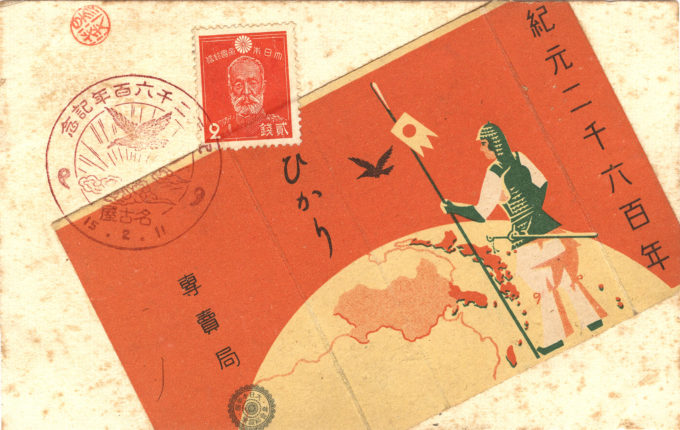
2600th Anniversary Founding of Japan commemorative postcard, Bureau of Crime Prevention, 1940. At the center of the image are the kana for ‘hikari’ (bright light, splendor) over a depiction of the Empire (the Home Islands, Chosen [Korea], Formosa, Karafuto [Sakhalin] and Manchukuo [Manchuria]). During the pre-war years, February 11 not only celebrated the “Founding of the Nation” in 660 B.C. but was also known as “Constitution Day”, celebrating the Meiji Constitution and its filial precepts. Since 1966, the date has been celebrated as National Foundation Day.
See also:
2600th Anniversary of the Founding of Japan, 1940.
“While Cardinal Principles of the National Polity went so far as to state outright that ‘our country is a divine country governed by an emperor who is a deity incarnate,’ it did not claim that all of the Japanese people were originally of divine descent. Rather, it was suggested that in ancient times Japan had been peopled by divinely descended clans ‘of one blood and one mind’ under the emperor, to whom subordinate groups of unrelated blood were affiliated. In time, however, all merged into one under the emperor.
“… [A] text entitled History of Japan which was translated into English by one of the government’s own tourism agencies in 1939 spoke of the ‘consanguineous unity’ of the nation, and the emergence over the centuries of ‘a race of admirable tendencies’ which was so thoroughly assimilated ‘that the imperial blood may be said to run in the veins of all Japanese, who have thus become kinsmen with one another, descended from a common ancestor.’ And who was that progenitor?
‘That common ancestor, or ancestress, is Amaterasu Omikami [the Sun Goddess]. The relations between the Imperial House and the people today may therefore be likened to those between the trunk and branches of a gigantic tree, for if we were to trace the genealogy of each Japanese subject, we would find that he belongs to a family, which centuries ago was either a direct or an indirect off-shoot of the Imperial Family … [H]aving a common ancestor in Amaterasu Omikami, our sovereign and his subjects are completely united like one man to form the Japanese nation and state.’
“Readers of the English-language Japan Times and Mail were treated to a similar argument on February 11, 1940, in a special edition commemorating the 2,600-year anniversary of the national founding.“The paper described the anniversary as a watershed in the ‘racial history’ of the Japanese people as they looked back on the heritage of the past and forward to the ‘promised of even greater attainments, a promise that is found in the deep consciousness of racial destiny that moves the soul of race …’
“… Although the newspaper did not press the point, it was the same account of Jimmu extending his sway over the diverse people of ancient Japan, based on a passage in the earliest written chronicles of Japan, dating from the eighth century, which inspired Japan’s World War Two slogan about the country’s divine mission to ‘bring all faces and nations of the world under ‘one roof”.”
– Race, Ethnicity and Migration in Modern Japan, edited by Michael Weiner, 2004

